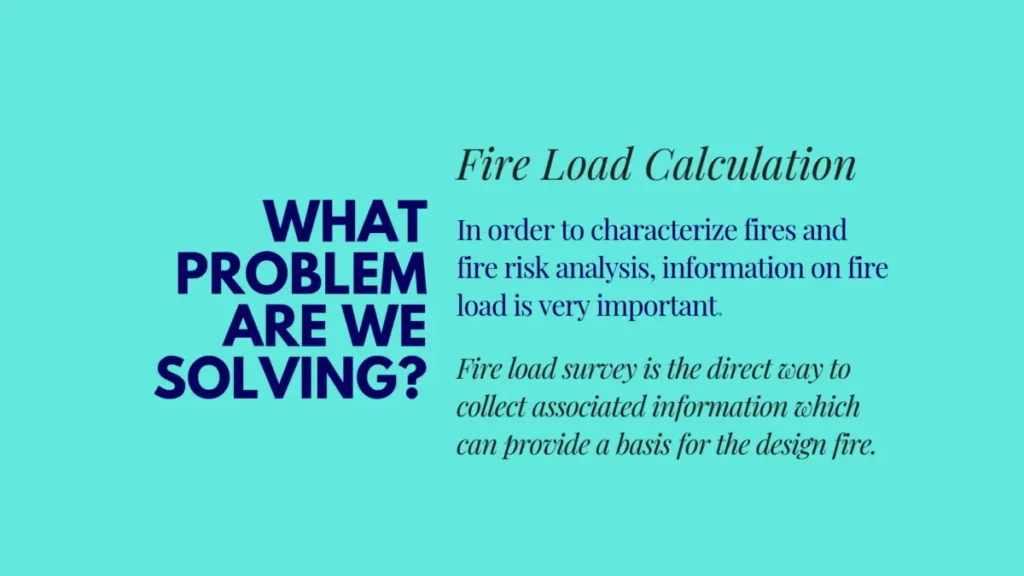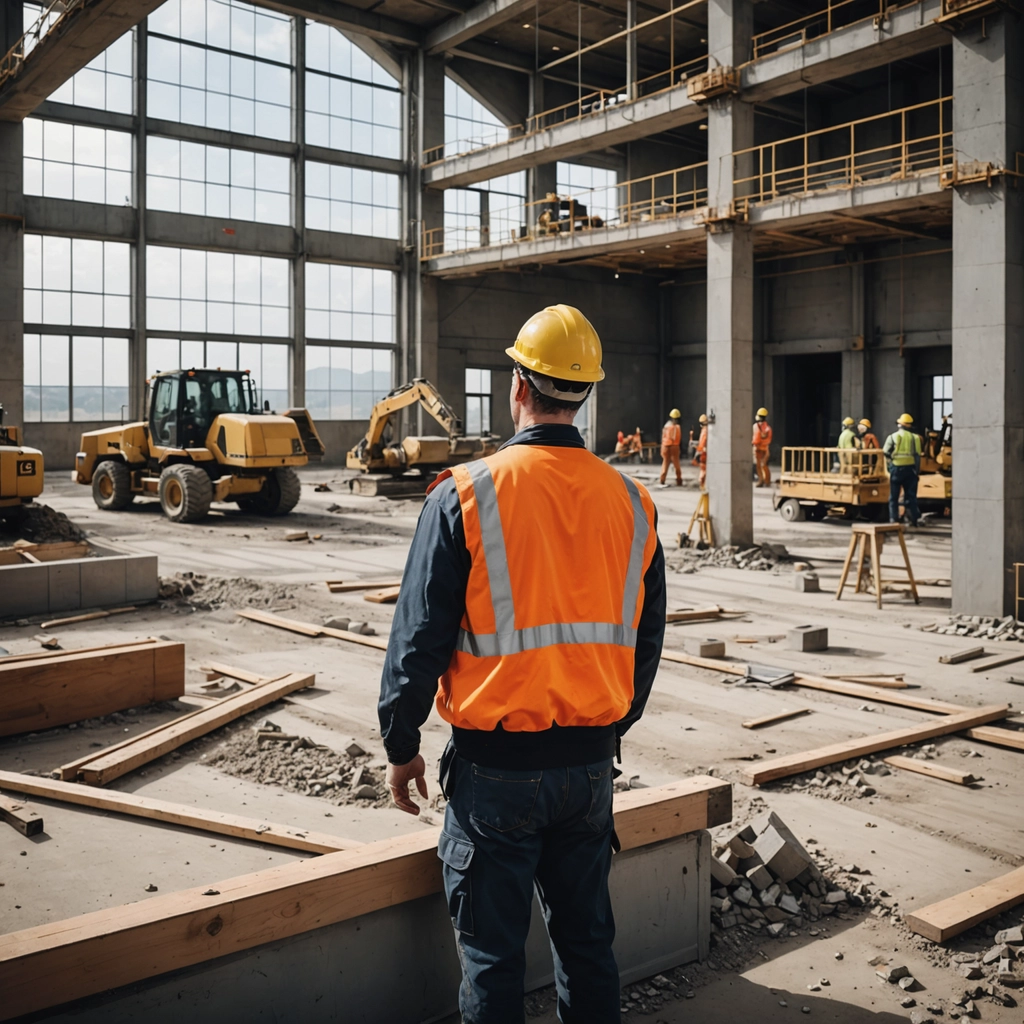The Fire Load Calculation Formula is a fundamental tool for assessing fire risks, fire intensity, and probable duration of fire.
As engineering solutions become more prevalent, it becomes crucial to identify, characterise, and quantify design fires.
The ignition, heat release, and flame temperature of design fires depend on the weight and arrangement of combustible materials.
During fire incidents, the amount of energy released is directly related to the mass of combustible materials, impacting fire intensity and duration. The composition of the fire load, exposed surface, and fresh air supply play significant roles in the heat release rate.
Verification of Fire Load is also an important element of any Fire Safety Audit.
Fire load density, a key parameter in fire load calculation, is used in numerical models and helps understand the severity of potential incidents and plan preventive and mitigation measures effectively.
Fire Load Calculation Formula and Fire Load
The fire load of a facility, industrial entity, process plant or building, is the heat energy that could be released per square meter of the floor area of a compartment, by the complete combustion of the contents of the unit area and any combustible parts of the unit.
It is a way of establishing the potential severity of a hypothetical future fire.
The heat output per unit floor area, often in kJ/m2, calculated from the calorific value of the materials present.
The fire load per unit area is defined as Fire Load Density
Fire load or Fire loading is used for evaluating industrial safety risks.
qc =∑ mvHv / Af
Where qc = fire load (MJ/m2)
Af= Floor area (m2)
mv= Total mass of the combustible material (Kg)and
Hv= Calorific value of the combustible material (MJ /Kg)
Why Fire Load Calculation is important?
In order to characterize fires, fire risk assessment, which provides detail information on fire load is very important. Fire load survey or Calculation of Fire Load is the direct way to collect associated information which can provide a basis for the design fire.

Some fundamentals
Fire Action
The fire action is defined as the total quantity of heat produced by the complete combustion of all combustible material in the fire compartment, inclusive of stored goods and equipment together with building structures and building materials.
The various loads should, therefore, be combined in accordance with the stipulations in the relevant design codes.
Design Fire
The design fire involves things like heat output, smoke production and toxic gases generation of a fire.
Information of toxic gases is of great importance in fire hazard assessment, while due to the complexity of combustion process it is difficult to quantify the type and amount of gaseous products generated in a real fire.
Heat Release Rate
It gives useful information such as the fire size, rate of smoke production, the possible fire environment, and other relevant data for hazard assessment.
The main factors that control the fire development at growth stage and fully developed stage are different.

Fire Load Calculation – How do we do it?
Movable contents:
Fire load consisting of combustible furniture, equipment, goods, and supplies brought in for the use of the occupant
Interior finish:
Fire load consisting of exposed combustible materials permanently affixed to walls, ceilings, or floors plus doors, trim, and built-in fixtures.
In cases where furnishings were fixed in place, estimates of weight were made on the basis of dimensions.
In addition, weights were estimated for combustible flooring and exposed woodwork other than flooring. These fixed, interior finish items were reported separately as well as combined with movable fire load to show the total fire load present.
However, larger compartments can generate higher temperatures, increased radiation, and higher burning rates. The effects of different thermal conductivities of enclosing walls on gas temperature are significant.
During the early stages where radiation is dominant, thermal inertia, kpc, is most important, while in the later stages where heat conduction loses predominance, thermal conductivity is most important.
The fire load calculation formula may also consider factors that determine the early or pre-flashover stages of fire growth. This is considerably more complex and can only be considered for high complex & hazardous entities.
In models of early fire growth, however, important parameters include the amount, surface area, and arrangement of combustible contents; the formation of openings in walls, ceilings or doors; and local zones of hot gases.
Fire Load Calculation Formula of buildings on the rise
Building Fire Safety | A study by researchers at the Indian Institute of Technology, Gandhinagar in the year 2018 has warned that the fire load in modern day buildings in India is three times greater than what was even as late as the 1990s.
Modern day buildings sport corrugated plastic roofs, partition walls, plastic doors, false ceiling panels, interior finish material, and have equipment like washing machines, refrigerators, air-conditioners, televisions, mobile electronic gadgets and computer hardware.
They found that average Fire Load Energy Density (FLED), which characterises fire loads of these units, was found to be around 1400 Mega Joules per square metre, which is about three times the average of 487 MJ/ sq. m found during a study done conducted just 20 years ago in Kanpur, India. The maximum expected temperatures in the first one hour were also much higher than in the previous study.
Identifying design fires is one of the most critical tasks in a performance-based fire safety design and critical for any Fire Audit. There are many methods used to characterise design fires.

Fire Load Calculation and Fire Severity
Fire severity is defined as the intensity and duration of a fire. To some extent, fire severity also expresses the concept of the potential for a fire to damage a structure or its contents.
Fire severity is considered in terms of the equivalent duration test.
The actual assessment of severity in any specific facility fire situation is largely a subjective matter and to a certain extent, depends upon the physical and thermal properties of the enclosing structure itself and the degree of ventilation involved.
Thus, temperature and the duration of burning in a compartment depend upon whether the walls and ceiling are good conductors or insulators and how much thermal energy is exhausted outside the burning room.
Considerations
Fire loads are calculated based on the conversion of mass into energy units (MJ) using the calorific value (heat release) of the corresponding material.
To simplify the fire load estimations, the estimation can be done the following assumptions:
Combustible materials are uniformly distributed throughout the building/facility
All combustible materials (with the exception of combustibles stored in suitable enclosures) in the fire compartment would undergo total combustion
Methods of Fire Loading
Several methods are used in fire load surveys in buildings, warehouses, as well as in industries. These are weighing, inventory, the combination of weighing and inventory.
The NFPA Standard 557 also proposes that a fire load survey can be conducted by either the weighing or the inventory technique or a combination of them. Each survey method has its own advantages and disadvantages.
Weighing method
In this method, fire load calculation is based on measured weights of combustibles and the corresponding calorific value of the materials. The necessary approximations are to be made in situations where items within the compartment did not match pre-weighed values.
The fire load is calculated using the calorific value (hc) of different materials to convert measured weights into energy units (MJ).
Inventory method
The inventory method calculates fire load based on the measured volume of items. Weights of items were obtained by multiplying the measured volume of combustibles by its density. This method did not use pre-weighed items and no direct measurement of mass is done.
Similar to the direct weighing method, items are classified under different homogeneous material groups. Fire loads are calculated from the masses of the items and their corresponding calorific value.
Combination method (weighing and Inventory)
This method uses data from the direct weighing method and inventory method. Weights of items are obtained from:
- directly weighing items
- pre-weighed items
- measured dimensions with subsequent conversion into weights through the use of the item’s material densities
Fire load is calculated by the product of item weights and their corresponding calorific values.
Data Analysis
Traditionally, fire load values using the direct weighing method would have been considered as the benchmark.
This is because it gives direct measurements of combustible weights with least uncertainty in fire load predictions. However, it is very difficult in practice.
Approximations are likely to increase the degree of uncertainty associated with the methods.
What are the reference standards for Fire Load Calculation?
There are in fact several reference standards (both prescriptive and performance based codes or standards) available globally for calculation of fire load. Few of them which are being used by industry are listed below:
Inputs for Fire Load Calculation
Situational or Seasonal impacts of the inventory
High-Rise Residential & Commercial Buildings
The number of fires in high-rise buildings is increasing in recent years. It is important to collect basic information that can help to develop the design fire for them.
When determining the heat release rate for a fire, the dominant factors in different stages should be considered. Since the design fire is affected by many factors, it is better to get more information about the combustion on a practical basis.
The magnitude of wind effect on high-rise building fires and its incorporation into the design fire is also important criteria.
Fire Management – A serious business risk
The evolving nature of risks poses a requirement of being regularly assessed and understood. The nature of risks globally has changed enormously. Their occurrences becoming more unexpected and their effects become more profound, risks need to be taken more seriously.
The risk of ‘Fire’ has been ranked fifth, up by three positions from last year’s ranking by India Risk Survey 2017 Report – FICCI & Pinkerton. According to NCRB (National Crime Records Bureau), a total of 18,450 cases of fire accidents were reported in India in 2015, with 1,193 persons injured and 17,700 killed. The cause-wise analysis of fire accidents concluded that 42.1% of deaths were due to fire accidents in residential buildings.
Accidental fires are the number 3 reason that causes most unnatural deaths in India after road accidents and drowning. Most of the fire accidents have been reported (Other than residential buildings) in Vehicles, Factories, Commercial Buildings, Hospitals and schools.
Business leadership is expected to devise fire risk-mitigation strategies, in order to create a secure business environment.
The Next Step
Once we complete the fire load calculation using Fire Load Calculation Formula, the next step is to conduct the Fire Risk Assessment FRA.
Fire Risk Assessment is an organised and methodical approach to detect, prevent and mitigate any hazard or condition that will lead to fire at your factory, building, warehouse, facility due to the activities carried out on your premises or by some external influences.
The basis of the process is a Fire Risk Assessment – that is conducted to investigate the likelihood that a fire could start and cause harm to those in and around the premises, based on the existing fire load in the location/property.
Equip yourself with essential skills and knowledge to protect lives and property. Join our most popular Fire Safety Training Course
Share this post
Category: Blog
Tags: Audit, Fire Safety, Fire Audit, Fire Risk Assessment, Fire Pre Plan
Related insights
View more in Impact Stories | Blogs | Knowledge Bank | News and Events















